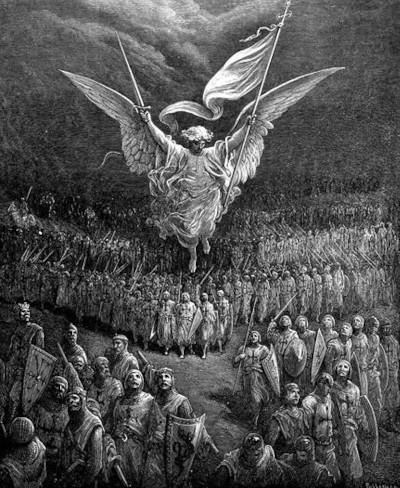The Road to Jerusalem is another example of Gustave Doré's work on The History of the Crusades, sometimes known as Histoire des Croisades. This French publication was written by Michaud and a new edition featured the illustrations provided by Doré.
The scene itself is a powerful, featuring a huge number of soldiers who are heading towards Jerusalem. Above them flies a winged figure, signifying how they believed they were carrying out God's work and had a divine protection over them. Michaud would chronicle the key events of the Crusades in a manner that was later evaluated by historians from the following centuries. This piece of literature provided many scenes of drama and emotion that were ideal fodder for a Romanticist artist such as Gustave Doré. He produced 100 drawings in total, with The Road to Jerusalem being amongst the most memorable of all. The series was published in two volumes in Paris, and was released in the French language, in line with the original texts by Michaud which were placed alongside Doré's own work. The commission came in the late 1870s, by which time he was already seen as the foremost book illustrator in either France or the UK, and had an established studio who could be trusted to faithfully reproduce his drawings as etchings or lithographs.
He would become so famous and in-demand that it became impossible for Doré to complete his commissions by himself. Over time, assistants would even complete some of the illustrations for him, with the master then signing them at a later date, if they passed the required level of quality. This was inevitable as more and more publishers attempted to make use of his services, with several hundred artworks required in some of the larger projects. He hired some specialist engravers who he could trust, with several respected figures running that side of the production. They would sign their own names in the bottom right of the engraved blocks, underlining their importance to the process. With such a strong income from book illustrations, Doré could easily employ dozens of assistants and still be left with a considerable profit. Over time his services would be sought in London, too, bringing a number of new patrons to his door.
These illustrations for The History of the Crusades were amongst his finest achievements. They displayed an artist at the top of his craft, who had worked as an illustrator for many decades and who understood the techniques involved. Few have managed to create such detailed and emotive scenes as he would do, and his career also came along at a time when interest in books was starting to rise in Europe. The increased levels of literacy helped to bring new customers to the doors of various publishers and this enabled them to be more ambitious with the titles that they offered. Religion was still prominent within western society at that time, and so there was still a strong thirst for information about the crusades which also touched heavily on historical content as well. Further items from the series included The Children's Crusade in 1212, The Crusaders' War Machinery and The Crusaders Massacre the Inhabitants of Caesarea.




